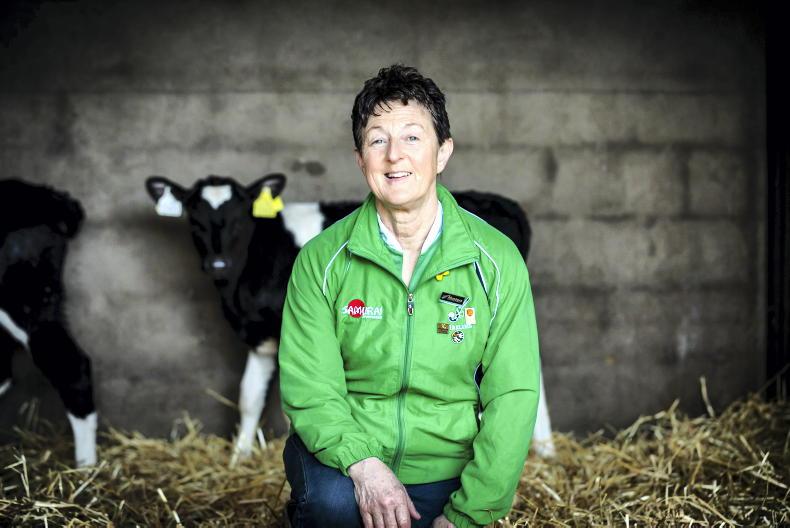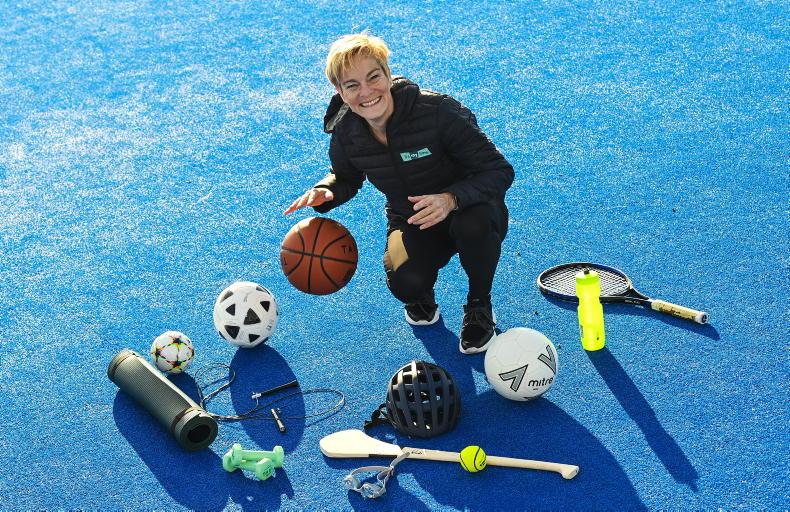Swimming a mile seems like a daunting undertaking and when Bethany Carson, Women in Sport Development Officer for Swim Ireland confidently states “if you can swim two lengths, I promise, you can swim a mile!” she has Irish Country Living intrigued.
From the Lisburn countryside, Bethany represented Ireland at European Championships, World University Games and Northern Ireland at Commonwealth Games for over ten years. When asked to help out at technique clinics for Swim for a Mile, Bethany found she loved the atmosphere of this event.
“Most people think of swimming lessons when they were in school, they don’t think about swim lessons from an adult’s perspective. It was such a nice experience to see adults really wanting to learn and apply their new skills,” she recalls of her early involvement with this all-island initiative.
With a goal to raise participation by helping people to become confident swimmers, Bethany notes that over 70% of participants are female. This may be as a result of the non-competitive element.
“You are only taking part on your own terms, it really is about getting in and going at your own pace and going the distance,” she assures us.
Open to all genders, the current programme is focused on supporting anyone from age 12 years up. There is a separate primary school programme that helps children by reaching the mile goal by swimming in relays. With the current indoor challenge due to take place in April, let’s take a deep dive at what is involved with Swim for a Mile (SFAM).
Swimming is a life skill
You can do it through your whole life cycle. While Swim for a Mile has a target of completing a set number of laps to reach the target of one mile, “any movement in the water whether it is aqua aerobics, water polo or diving is fantastic,” emphasises Bethany. With no stress on the joints and in the case of aqua aerobics, being ideal if you have little mobility or strength, these are activities you can do either as part of a regular routine or enjoy when away on holidays with family and friends.
“Oh, I am happy with my routine of doing my 20 laps, thank you”
For people who include swimming in their regular routine, trying something new can bring a fresh energy to hobbies. With Swim for a Mile, there is the option of doing a half mile too. In a standard 25 metre pool, one mile is reached on completion of 64 lengths. So, a half mile will be reached after 32 lengths.
Then again, as Bethany points out, “usually if you say a lap, this means two lengths” so by doing 20 laps you are already well over a half mile so you are doing really well anyway! Now there’s the coach coming out in her!
“Ah, I swim in a hotel pool that’s not 25metres, I can’t do it so…”
With shorter pools, the only difference is the amount of turns at either end and “turns are a real bonus” says Bethany. Look at turns as an opportunity to get a good start off from the wall. She adds “It is easier to swim in a shorter pool, the same in a competition, swimmers would have a lot faster time in a 25-metre pool than they would have in a 50-metre pool,” she adds.
“Your time will be quicker, that’s the only difference because the push off will give you more time.”
That is why they focus so much on the turns in the technique clinic, because they are so easy to make up time. Which leads us on to…
12 week training programme
This year, the indoor SFAM event takes place in pools throughout the country in April. The first thing you need to do is book your place [see box]. Then, you need to prepare. Swim Ireland have developed a free training programme for 20-metre, 25-metre and 50-metre pools, available to download from the website www.swimforamile.com that you can do in your own time. If you prefer, there is the option of signing up for a 12-week training programme to support you in reaching your goal. As this event is growing in popularity year on year, some pools are already booked out for training. Bethany acknowledges that breathing control is one of the biggest hurdles people struggle with when swimming so this is a big focus of the training programme “because once you get your confidence with your breath there is no stopping you!”

Swim for a Mile participants
You won't be under pressure from the local tri-athletes
When you enter SFAM (based on the estimated finishing time you give) you will be assigned to a lane with people of similar ability. If doing the training in person, there is a briefing at the beginning of each session and you can move to a faster/slower lane depending on what you feel comfortable with.
Etiquette
As part of the training programme, lane etiquette is covered?. For example, says Bethany, “If you find yourself coming up near the person in front of you, you touch their foot and let them know you are there and at the end of the lane they should pull in and let you in front.”
At training and on the event day, there would not be any more than five people in your lane and everyone is spaced ten seconds apart. “It can be a little bit daunting when you start but we go through all the steps and the coaches are more than happy if there are any questions – that’s what it is all about – improving your swimming,” says Bethany.
Strokes
Swimming the mile can be reached through a combination of front crawl and breaststroke. “It would not be safe to allow the butterfly or backstroke for health and safety reasons” says Bethany.
All Abilities
The first Swim for a Mile event takes place in Limerick on 4 April. Already there will be 30 Special Olympics athletes taking part on that day. One lane will be for a relay, there will be two lanes of mixed abilities and the rest of the lanes will be the general public. Everyone swims together and once the target is reached individually, participants cheer on everyone else.
Better, not faster
There may be some wheelchair users who find equipment like pull buoys (buoyancy aid) helpful, but in general, it is asked that equipment, such as flippers, are not used to help you go faster. Full-face masks are allowed if this helps you. For Bethany, helping people overcome challenges so they want to stay swimming is more important than going faster.
And that’s not all
If you are still not sure, download the free training programme on the website [see below]. They start very basic and build up gradually so you can complete this in your own time, at your own pace.
The amount of people that think they can’t swim a mile, and then they do it, it blows them away to think they can say proudly that they can swim for a mile. It is a great place to start- once you know you can swim this distance, then you might enter a triathlon, or take swimming up on a more regular basis with your children, or for holidays.
And if you prefer the great outdoors, you could always begin preparing for the outdoor challenge taking place in heated outdoor pools around the country, beginning in June.
SFAM event booking fee is €40 (plus 7% processing fee via Eventmaster, so full fee comes to €42.80).Technique Clinics can be booked at each pool indviually.For further information including booking, locations and technique clinics, please visit: https://www.swimforamile.com For information on setting up a relay entry for a community group or school, please contact Bethany directly, see contact page on website. Read more
‘Ursula Jacob on what the new sponsorship deal for the camogie association means
Kepak renews Meath ladies GAA sponsorship
Swimming a mile seems like a daunting undertaking and when Bethany Carson, Women in Sport Development Officer for Swim Ireland confidently states “if you can swim two lengths, I promise, you can swim a mile!” she has Irish Country Living intrigued.
From the Lisburn countryside, Bethany represented Ireland at European Championships, World University Games and Northern Ireland at Commonwealth Games for over ten years. When asked to help out at technique clinics for Swim for a Mile, Bethany found she loved the atmosphere of this event.
“Most people think of swimming lessons when they were in school, they don’t think about swim lessons from an adult’s perspective. It was such a nice experience to see adults really wanting to learn and apply their new skills,” she recalls of her early involvement with this all-island initiative.
With a goal to raise participation by helping people to become confident swimmers, Bethany notes that over 70% of participants are female. This may be as a result of the non-competitive element.
“You are only taking part on your own terms, it really is about getting in and going at your own pace and going the distance,” she assures us.
Open to all genders, the current programme is focused on supporting anyone from age 12 years up. There is a separate primary school programme that helps children by reaching the mile goal by swimming in relays. With the current indoor challenge due to take place in April, let’s take a deep dive at what is involved with Swim for a Mile (SFAM).
Swimming is a life skill
You can do it through your whole life cycle. While Swim for a Mile has a target of completing a set number of laps to reach the target of one mile, “any movement in the water whether it is aqua aerobics, water polo or diving is fantastic,” emphasises Bethany. With no stress on the joints and in the case of aqua aerobics, being ideal if you have little mobility or strength, these are activities you can do either as part of a regular routine or enjoy when away on holidays with family and friends.
“Oh, I am happy with my routine of doing my 20 laps, thank you”
For people who include swimming in their regular routine, trying something new can bring a fresh energy to hobbies. With Swim for a Mile, there is the option of doing a half mile too. In a standard 25 metre pool, one mile is reached on completion of 64 lengths. So, a half mile will be reached after 32 lengths.
Then again, as Bethany points out, “usually if you say a lap, this means two lengths” so by doing 20 laps you are already well over a half mile so you are doing really well anyway! Now there’s the coach coming out in her!
“Ah, I swim in a hotel pool that’s not 25metres, I can’t do it so…”
With shorter pools, the only difference is the amount of turns at either end and “turns are a real bonus” says Bethany. Look at turns as an opportunity to get a good start off from the wall. She adds “It is easier to swim in a shorter pool, the same in a competition, swimmers would have a lot faster time in a 25-metre pool than they would have in a 50-metre pool,” she adds.
“Your time will be quicker, that’s the only difference because the push off will give you more time.”
That is why they focus so much on the turns in the technique clinic, because they are so easy to make up time. Which leads us on to…
12 week training programme
This year, the indoor SFAM event takes place in pools throughout the country in April. The first thing you need to do is book your place [see box]. Then, you need to prepare. Swim Ireland have developed a free training programme for 20-metre, 25-metre and 50-metre pools, available to download from the website www.swimforamile.com that you can do in your own time. If you prefer, there is the option of signing up for a 12-week training programme to support you in reaching your goal. As this event is growing in popularity year on year, some pools are already booked out for training. Bethany acknowledges that breathing control is one of the biggest hurdles people struggle with when swimming so this is a big focus of the training programme “because once you get your confidence with your breath there is no stopping you!”

Swim for a Mile participants
You won't be under pressure from the local tri-athletes
When you enter SFAM (based on the estimated finishing time you give) you will be assigned to a lane with people of similar ability. If doing the training in person, there is a briefing at the beginning of each session and you can move to a faster/slower lane depending on what you feel comfortable with.
Etiquette
As part of the training programme, lane etiquette is covered?. For example, says Bethany, “If you find yourself coming up near the person in front of you, you touch their foot and let them know you are there and at the end of the lane they should pull in and let you in front.”
At training and on the event day, there would not be any more than five people in your lane and everyone is spaced ten seconds apart. “It can be a little bit daunting when you start but we go through all the steps and the coaches are more than happy if there are any questions – that’s what it is all about – improving your swimming,” says Bethany.
Strokes
Swimming the mile can be reached through a combination of front crawl and breaststroke. “It would not be safe to allow the butterfly or backstroke for health and safety reasons” says Bethany.
All Abilities
The first Swim for a Mile event takes place in Limerick on 4 April. Already there will be 30 Special Olympics athletes taking part on that day. One lane will be for a relay, there will be two lanes of mixed abilities and the rest of the lanes will be the general public. Everyone swims together and once the target is reached individually, participants cheer on everyone else.
Better, not faster
There may be some wheelchair users who find equipment like pull buoys (buoyancy aid) helpful, but in general, it is asked that equipment, such as flippers, are not used to help you go faster. Full-face masks are allowed if this helps you. For Bethany, helping people overcome challenges so they want to stay swimming is more important than going faster.
And that’s not all
If you are still not sure, download the free training programme on the website [see below]. They start very basic and build up gradually so you can complete this in your own time, at your own pace.
The amount of people that think they can’t swim a mile, and then they do it, it blows them away to think they can say proudly that they can swim for a mile. It is a great place to start- once you know you can swim this distance, then you might enter a triathlon, or take swimming up on a more regular basis with your children, or for holidays.
And if you prefer the great outdoors, you could always begin preparing for the outdoor challenge taking place in heated outdoor pools around the country, beginning in June.
SFAM event booking fee is €40 (plus 7% processing fee via Eventmaster, so full fee comes to €42.80).Technique Clinics can be booked at each pool indviually.For further information including booking, locations and technique clinics, please visit: https://www.swimforamile.com For information on setting up a relay entry for a community group or school, please contact Bethany directly, see contact page on website. Read more
‘Ursula Jacob on what the new sponsorship deal for the camogie association means
Kepak renews Meath ladies GAA sponsorship












SHARING OPTIONS